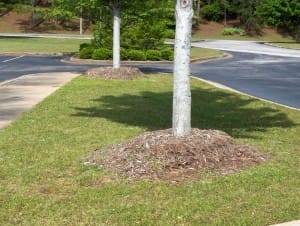Source(s): Chris Starbuck, Woody Ornamental Horticulture, Cooperative Extension, University of Missouri.
Mulching is one of the most important cultural practices to help new trees and shrubs get established and keep them healthy. Mulch conserves soil moisture, moderates soil temperature, reduces competition from roots of weeds and turf and generally facilitates penetration of water to the roots of woody plants. However, as the old saying goes, “too much of a good thing, is not a good thing.”
A common mulching practice now being used by some landscapers is to place mulch in a 2- to 3-foot diameter circle and 8 to 12 inches deep around newly-planted trees and shrubs. The mulch material is simply piled up and around the trunk to form a “volcano.” Although it may be said that a mulch volcano is generally better than no mulch at all, volcano-mulching can have serious negative effects on plant health. First, when mulch is placed more than about 4 inches deep, roots tend to “migrate” up into the mulch during rainy periods or when the area is irrigated. This is partly due to (temporarily) favorable root growth conditions in the mulch and partly to the suffocation of deep roots due to mulch-induced water-logging of the underlying soil. Then, when drought conditions occur, volcano-mulched plants may come under severe stress because many roots are growing in the mulch material which has considerably less water-holding capacity than real soil.
Another problem sometimes associated with mulch volcanoes that can kill new trees is the “umbrella” effect. The surfaces of mulch volcanoes around shrubs and trees can become hydrophobic due to fungal activity and act very effectively as umbrellas, shedding water to the surrounding area. This is more common in high carbon mulches like ground wood, wood chips or sawdust, but it can also occur in bark mulches. It should be kept firmly in mind that until a newly-planted tree can grow roots out of the original soil ball and into the surrounding soil, the tree is absolutely dependent on moisture in the original ball. If the soil ball is kept dry by a mulch umbrella/volcano, the tree will suffer severe drought stress during the establishment period.
Other possible problems associated with mulch volcanoes include: the promotion of fungal canker diseases caused by the presense of constant moisture around the lower trunk; stress from poor gas exchange by the cells in the bark that results in bark decay; and damage from termites and rodents that may make take up residence in the volcano.
When deciding on the best approach for mulching trees and shrubs in the landscape, go for a walk in the woods to see how Mother Nature does it. Trees in their native habitats rarely have individual mulch rings. Plants tend to share a large common soil volume that is nicely mulched by decomposing leaves that are releasing minerals to the soil. Also, the mulch layer is rarely more than 2 inches thick and never in the form of a volcano
Center Publication Number: 219
- Volcano Mulching - September 22, 2013
